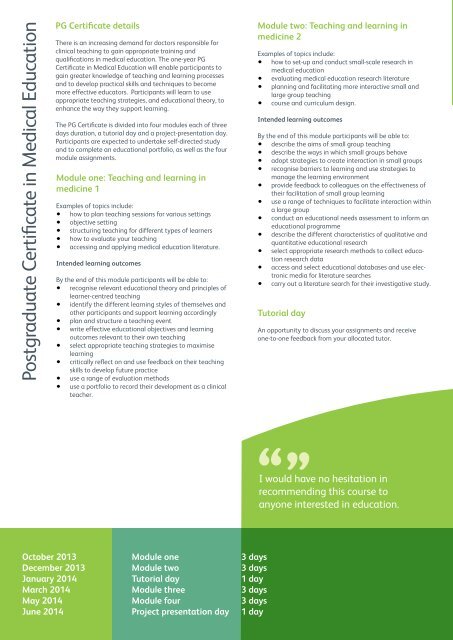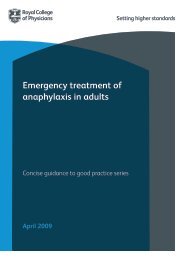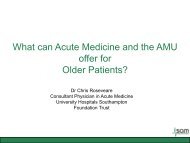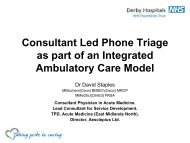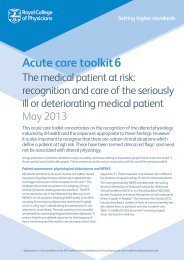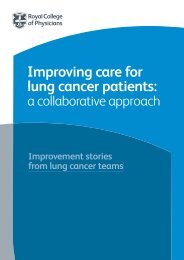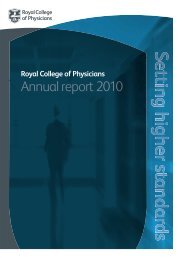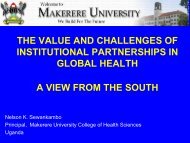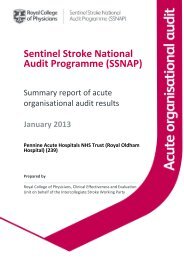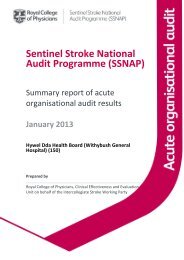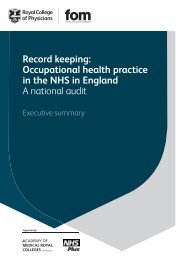MSc in Medical Education 2013/14 prospectus - Royal College of ...
MSc in Medical Education 2013/14 prospectus - Royal College of ...
MSc in Medical Education 2013/14 prospectus - Royal College of ...
Create successful ePaper yourself
Turn your PDF publications into a flip-book with our unique Google optimized e-Paper software.
Postgraduate Certificate <strong>in</strong> <strong>Medical</strong> <strong>Education</strong>PG Certificate detailsThere is an <strong>in</strong>creas<strong>in</strong>g demand for doctors responsible forcl<strong>in</strong>ical teach<strong>in</strong>g to ga<strong>in</strong> appropriate tra<strong>in</strong><strong>in</strong>g andqualifications <strong>in</strong> medical education. The one-year PGCertificate <strong>in</strong> <strong>Medical</strong> <strong>Education</strong> will enable participants toga<strong>in</strong> greater knowledge <strong>of</strong> teach<strong>in</strong>g and learn<strong>in</strong>g processesand to develop practical skills and techniques to becomemore effective educators. Participants will learn to useappropriate teach<strong>in</strong>g strategies, and educational theory, toenhance the way they support learn<strong>in</strong>g.The PG Certificate is divided <strong>in</strong>to four modules each <strong>of</strong> threedays duration, a tutorial day and a project-presentation day.Participants are expected to undertake self-directed studyand to complete an educational portfolio, as well as the fourmodule assignments.Module one: Teach<strong>in</strong>g and learn<strong>in</strong>g <strong>in</strong>medic<strong>in</strong>e 1Examples <strong>of</strong> topics <strong>in</strong>clude:• how to plan teach<strong>in</strong>g sessions for various sett<strong>in</strong>gs• objective sett<strong>in</strong>g• structur<strong>in</strong>g teach<strong>in</strong>g for different types <strong>of</strong> learners• how to evaluate your teach<strong>in</strong>g• access<strong>in</strong>g and apply<strong>in</strong>g medical education literature.Intended learn<strong>in</strong>g outcomesBy the end <strong>of</strong> this module participants will be able to:• recognise relevant educational theory and pr<strong>in</strong>ciples <strong>of</strong>learner-centred teach<strong>in</strong>g• identify the different learn<strong>in</strong>g styles <strong>of</strong> themselves andother participants and support learn<strong>in</strong>g accord<strong>in</strong>gly• plan and structure a teach<strong>in</strong>g event• write effective educational objectives and learn<strong>in</strong>goutcomes relevant to their own teach<strong>in</strong>g• select appropriate teach<strong>in</strong>g strategies to maximiselearn<strong>in</strong>g• critically reflect on and use feedback on their teach<strong>in</strong>gskills to develop future practice• use a range <strong>of</strong> evaluation methods• use a portfolio to record their development as a cl<strong>in</strong>icalteacher.Module two: Teach<strong>in</strong>g and learn<strong>in</strong>g <strong>in</strong>medic<strong>in</strong>e 2Examples <strong>of</strong> topics <strong>in</strong>clude:• how to set-up and conduct small-scale research <strong>in</strong>medical education• evaluat<strong>in</strong>g medical education research literature• plann<strong>in</strong>g and facilitat<strong>in</strong>g more <strong>in</strong>teractive small andlarge group teach<strong>in</strong>g• course and curriculum design.Intended learn<strong>in</strong>g outcomesBy the end <strong>of</strong> this module participants will be able to:• describe the aims <strong>of</strong> small group teach<strong>in</strong>g• describe the ways <strong>in</strong> which small groups behave• adopt strategies to create <strong>in</strong>teraction <strong>in</strong> small groups• recognise barriers to learn<strong>in</strong>g and use strategies tomanage the learn<strong>in</strong>g environment• provide feedback to colleagues on the effectiveness <strong>of</strong>their facilitation <strong>of</strong> small group learn<strong>in</strong>g• use a range <strong>of</strong> techniques to facilitate <strong>in</strong>teraction with<strong>in</strong>a large group• conduct an educational needs assessment to <strong>in</strong>form aneducational programme• describe the different characteristics <strong>of</strong> qualitative andquantitative educational research• select appropriate research methods to collect educationresearch data• access and select educational databases and use electronicmedia for literature searches• carry out a literature search for their <strong>in</strong>vestigative study.Tutorial dayAn opportunity to discuss your assignments and receiveone-to-one feedback from your allocated tutor.Postgraduate Certificate <strong>in</strong> <strong>Medical</strong> <strong>Education</strong>Module three: Assessment <strong>in</strong> <strong>Medical</strong><strong>Education</strong>Examples <strong>of</strong> topics <strong>in</strong>clude:• improv<strong>in</strong>g bedside and on-the-job teach<strong>in</strong>g• the role <strong>of</strong> patients <strong>in</strong> teach<strong>in</strong>g• teach<strong>in</strong>g cl<strong>in</strong>ical reason<strong>in</strong>g• explor<strong>in</strong>g the purpose and pr<strong>in</strong>ciples <strong>of</strong> assessment• apply<strong>in</strong>g blue pr<strong>in</strong>ts, matrices and standard sett<strong>in</strong>g toassessment.Intended learn<strong>in</strong>g outcomesBy the end <strong>of</strong> this module students will be able to:• identify the purposes <strong>of</strong> assessment• def<strong>in</strong>e validity, reliability, transparency, feasibility andeducational impact when applied to assessment• choose appropriate assessment methods accord<strong>in</strong>g tothe purpose <strong>of</strong> the assessment• construct a bluepr<strong>in</strong>t for an assessment <strong>in</strong> their ownspecialty• assess performance <strong>in</strong> structured cl<strong>in</strong>ical exam<strong>in</strong>ations• assist tra<strong>in</strong>ee doctors <strong>in</strong> identify<strong>in</strong>g learn<strong>in</strong>g objectivesand complet<strong>in</strong>g a personal development plan• handle underperformance <strong>of</strong> tra<strong>in</strong>ee doctors• expla<strong>in</strong> the pr<strong>in</strong>ciples <strong>of</strong> performance and how tomeasure it• use different methods <strong>of</strong> workplace-based assessment<strong>in</strong> a way that ensures validity, reliability, transparency,feasibility and educational impact• give effective feedback on workplace-based assessment.Module four: <strong>Education</strong>al Supervision andCl<strong>in</strong>ical Teach<strong>in</strong>gExamples <strong>of</strong> topics <strong>in</strong>clude:• explor<strong>in</strong>g 21st century apprenticeship• the role <strong>of</strong> mentor<strong>in</strong>g <strong>in</strong> medical education• how to manage poor performance• improv<strong>in</strong>g workplace-based assessment and appraisal• address<strong>in</strong>g pr<strong>of</strong>essional attitudes and behaviours• an <strong>in</strong>troduction to e-learn<strong>in</strong>g.Intended learn<strong>in</strong>g outcomesBy the end <strong>of</strong> this module participants should be able to:• identify the role <strong>of</strong> the educational supervisor• recognise opportunities for teach<strong>in</strong>g <strong>in</strong> the cl<strong>in</strong>icalsett<strong>in</strong>g• select appropriate strategies when teach<strong>in</strong>g <strong>in</strong> a range<strong>of</strong> cl<strong>in</strong>ical sett<strong>in</strong>gs• assist learners to reflect on their experiences throughquestion<strong>in</strong>g and effective feedback• identify a range <strong>of</strong> methods for nurtur<strong>in</strong>g appropriatecl<strong>in</strong>ical attitudes• identify the range <strong>of</strong> resources available for cl<strong>in</strong>icalteach<strong>in</strong>g• develop ways <strong>of</strong> <strong>in</strong>volv<strong>in</strong>g patients <strong>in</strong> teach<strong>in</strong>g• identify approaches for teach<strong>in</strong>g cl<strong>in</strong>icalcommunication• apply education theory to bedside teach<strong>in</strong>g• adapt their teach<strong>in</strong>g to encourage the development <strong>of</strong>cl<strong>in</strong>ical reason<strong>in</strong>g• reflect on and identify areas for improvement <strong>in</strong> theirown teach<strong>in</strong>g.Project Presentation Day““ I would have no hesitation <strong>in</strong>recommend<strong>in</strong>g this course toanyone <strong>in</strong>terested <strong>in</strong> education.A day where all participants deliver a short presentationbased on their action research project, <strong>in</strong>clud<strong>in</strong>g prelim<strong>in</strong>arydiscussion around the <strong>in</strong>itial results and how they plan toprogress and complete the project. There will be allocatedtime for feedback from peers and a question and answersession to provide guidance for the completion <strong>of</strong>participants’ studies.AssessmentThe PG Certificate is assessed by a written assignment l<strong>in</strong>kedto each module (four 2,500 word assignments). The f<strong>in</strong>alreport is on an action research project relat<strong>in</strong>g to aneducational issue that is relevant to your work, or aneducational <strong>in</strong>itiative that you have <strong>in</strong>troduced <strong>in</strong> yourworkplace.October <strong>2013</strong> Module one 3 daysDecember <strong>2013</strong> Module two 3 daysJanuary 20<strong>14</strong> Tutorial day 1 dayMarch 20<strong>14</strong> Module three 3 daysMay 20<strong>14</strong> Module four 3 daysJune 20<strong>14</strong> Project presentation day 1 day


